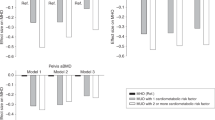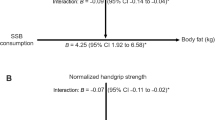Abstract
Background/Objective:
The objective of this study is to compare the growth and physical fitness of normal, stunted and overweight/obese (owt/ob) Oaxaca children 6–13 years.
Subjects/Methods:
This study was a cross-sectional, included 688 school children (grades 1–3, 4–6), aged 6–13 years, from an indigenous rural community (n=361) and colonia popular (n=327) in Oaxaca, southern Mexico. Measurements: Anthropometry—weight, height, sitting height, limb circumferences, skinfolds. Derived—body mass index, sitting height/height ratio, leg and step lengths, limb muscle areas, sum of skinfolds. Physical fitness—sit and reach, sit-ups, distance run, grip strength, standing long jump, 35 yard dash. Physical activity—steps to and from school, household chores, sports participation. Analysis: Normal—not stunted, not owt/ob; stunted—not owt/ob; and owt/ob—not stunted were compared with multivariate analysis of covariance controlling for age. Two children were stunted and owt/ob, and were excluded.
Results:
Age-adjusted means for body size, muscularity, adiposity and grip strength showed a gradient, owt/ob>normal>stunted in both sexes and grade levels (P<0.001). Relative position of stunted and owt/ob children was reversed for strength per unit mass. Stunted and normal children ran a greater distance than owt/ob children (P<0.05). Normal, stunted and owt/ob children did not differ consistently in other fitness items and indicators of activity and inactivity.
Conclusion:
Size, muscularity, fatness and strength differed significantly, owt/ob>normal>stunted, but owt/ob children had less strength per unit mass and poorer endurance. Normal and stunted children did not differ consistently in fitness. Physical activity and television time did not differ among the three groups.
This is a preview of subscription content, access via your institution
Access options
Subscribe to this journal
Receive 12 print issues and online access
$259.00 per year
only $21.58 per issue
Buy this article
- Purchase on Springer Link
- Instant access to full article PDF
Prices may be subject to local taxes which are calculated during checkout
Similar content being viewed by others
References
Ainsworth BE, Haskell WL, Whitt MC, Irwin ML, Swartz AM, Strath SJ et al. (2000). Compendium of physical activities: an update of activity codes and MET intensities. Med Sci Sports Exerc 32 (suppl), S498–S516.
Bar-Or O, Rowland TW (2004). Pediatric Exercise Medicine. Human Kinetics: Champaign, IL.
Benefice E (1993). Physical activity, cardiorespiratory fitness, motor performance, and growth of Senegalese pre-adolescents. Am J Hum Biol 5, 653–667.
Benefice E (1998). Growth and motor performance of rural Senegalese children. Med Sport Sci 43, 117–131.
Beunen G, Malina RM, Ostyn M, Renson R, Simons J, Van Gerven D (1983). Fatness, growth and motor fitness of Belgian boys 12 through 20 years of age. Hum Biol 55, 599–613.
Bouchard C, Shephard RJ (1994). Physical activity, fitness, and health: the model and key concepts. In: Bouchard C, Shephard RJ, Stephends T (eds). Physical Activity, Fitness, and Health. Human Kinetics: Champaign, IL, pp 77–88.
Bovet P, Auguste R, Burdette H (2007). Strong inverse association between physical fitness and overweight in adolescents: a large school-based survey. Int J Behav Nutr Phys Act 4, 24–31.
Clarke HH (1971). Basic Understanding of Physical Fitness. Physical Fitness Research Digest, series 1, no 1. President's Council on Physical Fitness and Sports: Washington, DC.
Cole TJ, Bellizzi MC, Flegal KM, Dietz WH (2000). Establishing a standard definition for child overweight and obesity worldwide: International survey. Br Med J 320, 1240–1243.
Dufour DL (1997). Nutrition, activity, and health in children. Ann Rev Anthropol 26, 541–565.
Fellmann N, Bedu M, Coudert J (1998). Aerobic and anaerobic performances in relation to marginal malnutrition and altitude in Bolivian boys and girls. Med Sport Sci 43, 79–93.
Fernald LC, Neufeld LM (2007). Overweight with concurrent stunting in very young children from rural Mexico: prevalence and associated factors. Eur J Clin Nutr 61, 523–632.
Graf C, Koch B, Kretschmann-Kandel E, Falkowski G, Christ H, Coburger S et al. (2004). Correlation between BMI, leisure habits and motor abilities in childhood (CHILT-Project). Int J Obes 28, 22–26.
Henneberg M, Harrison GA, Brush G (1998). The small child: anthropometric and physical performance of short-for-age children growing in good and in poor socio-economic conditions. Eur J Clin Nutr 52, 286–291.
Hernandez B, Gortmaker SL, Colditz GA, Peterson KE, Laird NM, Parra-Cabrera S (1999). Association of obesity with physical activity, television programs and other forms of video viewing among children in Mexico City. Int J Obes 23, 845–854.
Hoffman DJ, Sawaya AL, Verreschi I, Tucker KL, Roberts SB (2000). Why are nutritionally stunted children at increased risk of obesity? Studies of metabolic rate and fat oxidation in shantytown children from Sao Paulo, Brazil. Am J Clin Nutr 72, 702–707.
Huang YC, Malina RM (2007). BMI and health-related physical fitness in Taiwanese youth 9–18 years. Med Sci Sports Exerc 39, 701–708.
Huang YC, Malina RM (2010). BMI and individual physical fitness tests in Taiwanese youth 9–18 years. Int J Pediatr Obes 5, 404–411.
Kuczmarski RJ, Ogden CL, Grummer-Strawn LM, Flegal KM, Guo SS, Wei R et al. (2000). CDC growth charts: United States. Advance Data from Vital and Health Statistics, no 314. National Center for Health Statistics: Hyattsville, MD.
Malina RM (1984). Physical activity and motor development/performance in populations nutritionally at risk. In: Pollitt E, Amante P (eds). Energy Intake and Physical Activity. Alan R Liss: New York, NY, pp 285–302.
Malina RM (1986). Motor development and performance of children and youth in undernourished populations. In: Katch FI (ed). Sport, Health, and Nutrition. Human Kinetics: Champaign, IL, pp 213–226.
Malina RM (1991). Fitness and performance: adult health and the culture of youth. American Academy of Physical Education Papers, no 24. Human Kinetics: Champaign, IL, pp 30–38.
Malina RM (1995). Anthropometry. In: Maud PJ, Foster C (eds). Physiological Assessment of Human Fitness. Human Kinetics: Champaign, IL, pp 205–219.
Malina RM (2001). Childhood and adolescent obesity: selected issues and implications. In: Johnston FE, Foster GD (eds). Obesity, Growth and Development. Smith-Gordon: London, pp 1–20.
Malina RM, Beunen GP, Claessens AL, Lefevre J, Vanden Eynde B, Renson R et al. (1995). Fatness and fitness of girls 7–17 years. Obes Res 3, 221–231.
Malina RM, Bouchard C, Bar-Or O (2004). Growth, Maturation and Physical Activity, 2nd edn. Human Kinetics: Champaign, IL.
Malina RM, Little BB, Buschang PH (1991). Estimated body composition and strength of chronically mild-to-moderately undernourished rural boys in southern Mexico. Med Sport Sci 31, 119–132.
Malina RM, Katzmarzyk PT (2006). Physical activity and fitness in an international growth standard for preadolescent and adolescent children. Food Nutr Bull 27 (Suppl), S295–S313.
Malina RM, Peña Reyes M, Little BB (2008a). Historia natural del crecimiento de niños y púberes en una comunidad indígena: el Proyecto Oaxaca. Cuadernos de Nutricion 31, 207–214.
Malina RM, Peña Reyes M, Little BB (2008b). Secular change in the growth status of urban and rural schoolchildren aged 6–13 years in Oaxaca, southern Mexico. Ann Hum Biol 35, 475–489.
Malina RM, Peña Reyes M, Little BB (2009). Socioeconomic variation in the growth status of urban school children 6–13 years in Oaxaca, Mexico, in 1972 and 2000. Am J Hum Biol 21, 805–816.
Malina RM, Peña Reyes M, Tan SK, Little BB (2008c). Physical activity in youth from a subsistence agriculture community in the Valley of Oaxaca, southern Mexico. Appl Physiol Nutr Metab 33, 819–830.
Monyeki MA, Koppes LLJ, Kemper HCG, Monyeki KD, Toriola AL, Pienaar AE et al. (2005). Body composition and physical fitness of undernourished South African rural primary school children. Eur J Clin Nutr 59, 877–883.
Okely AD, Booth ML, Chey T (2004). Relationships between body composition and fundamental movement skills among children and adolescents. Res Q Exerc Sport 75, 238–247.
Peña Reyes ME, Bali Chavez G, Little BB, Malina RM (2010). Community well-being and growth status of indigenous school children in rural Oaxaca, southern Mexico. Eco Hum Biol 8, 177–187.
Peña Reyes ME, Cárdenas Barahona EE, Lamadrid PS, del Olmo Calzada M, Malina RM (2009). Growth status of indigenous school children 6–14 years in the Tarahumara Sierra, Northern Mexico, in 1990 and 2007. Ann Hum Biol 36, 756–769.
Peña-Reyes ME, Tan SK, Malina RM (2003a). Urban-rural contrasts in growth status of school children in Oaxaca, Mexico. Ann Hum Biol 30, 693–713.
Peña-Reyes ME, Tan SK, Malina RM (2003b). Urban-rural contrasts in the physical fitness of school children in Oaxaca, Mexico. Am J Hum Biol 15, 800–814.
Popkin BM (1994). The nutrition transition in low-income countries: an emerging crisis. Nutr Rev 52, 285–298.
Popkin BM, Richards MK, Monteiro CA (1996). Stunting is associated with overweight in children of four nations that are undergoing the nutrition transition. J Nutr 126, 3009–3016.
Prista A (1998). Nutritional status, physical fitness and physical activity in children and youth in Maputo (Mozambique). Med Sport Sci 43, 94–104.
Reina JC, Spurr GB (1984). Daily activity level of marginally malnourished school-aged girls: a preliminary report. In: Pollitt E, Amante P (eds). Energy Intake and Physical Activity. Alan R Liss: New York, NY, pp 263–283.
Rivera JA, Barquera S, Gonzalez-Cossio T, Olaiz G, Sepulveda J (2004). Nutrition transition in Mexico and in other Latin American countries. Nutr Rev 62, S149–S157.
Roldan JA, Ávila A, Chávez A, Alvarez M, Muñoz M, Shamah R (2004). Regionalización de la Situación Nutricional en México: A Través de un Índice de Riesgo Nutricional por Municipio. Instituto Nacional de la Nutricion Salvador Zubirán: Mexico, DF.
Seefeldt V, Haubenstricker J (1982). Patterns, phases, or stages: An analytical model for the study of developmental movement. In: Kelso JSA, Clark JE (eds). The Development of Movement Control and Coordination. Wiley: New York, NY, pp 309–319.
Siegel SR, Malina RM, Peña Reyes ME, Cárdenas Barahona EE (2011). Estimated physical activity and inactivity in urban Mexican youth. J Coimbra Network Sport Sci 4, 11–29.
Spurr GB (1983). Nutritional status and physical work capacity. Yrbk Phys Anthropol 26, 1–25.
Spurr GB (1990). Physical activity and energy expenditure in undernutrition. Prog Food Nutr Sci 14, 139–192.
Spurr GB, Barac-Nieto M, Reina JC (1991). Growth, maturation, body composition and maximal aerobic power of nutritionally normal and marginally malnourished school-aged Colombian children. Med Sport Sci 31, 41–60.
Acknowledgements
We acknowledged and greatly appreciated the cooperation of community leaders, school authorities, parents and children in the two communities. The assistance of Alma Garcia Montes, David Lopez Romero, Marcos Ramirez Hernandez and Arturo Ramirez Ortiz of the Escuela Nacional de Antropologia e Historia of Mexico is also acknowledged and greatly appreciated. This study is supported by the National Science Foundation grant BCS 9816400.
Author information
Authors and Affiliations
Corresponding author
Ethics declarations
Competing interests
The authors declare no conflict of interest.
Rights and permissions
About this article
Cite this article
Malina, R., Reyes, M., Tan, S. et al. Physical fitness of normal, stunted and overweight children 6–13 years in Oaxaca, Mexico. Eur J Clin Nutr 65, 826–834 (2011). https://doi.org/10.1038/ejcn.2011.44
Received:
Revised:
Accepted:
Published:
Issue Date:
DOI: https://doi.org/10.1038/ejcn.2011.44
Keywords
This article is cited by
-
Underweight children are agile but lack power
BMC Pediatrics (2022)
-
Muscular Fitness and Cardiometabolic Variables in Children and Adolescents: A Systematic Review
Sports Medicine (2022)
-
Sibling Resemblances in Physical Fitness in Three Distinct Regions in Peru: The Peruvian Sibling Study on Growth and Health
Behavior Genetics (2022)
-
The Health Benefits of Muscular Fitness for Children and Adolescents: A Systematic Review and Meta-Analysis
Sports Medicine (2014)



